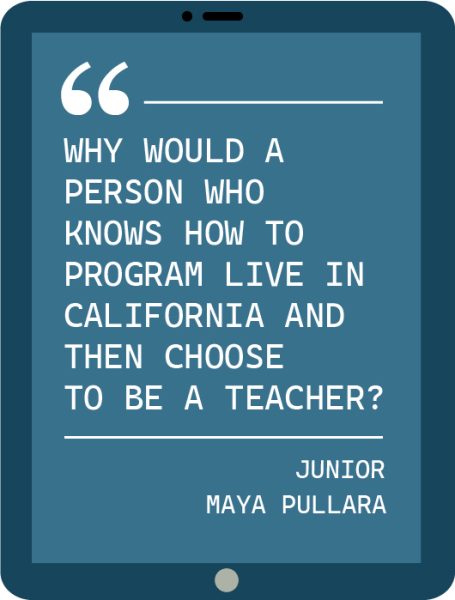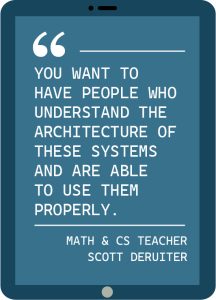Governor Gavin Newsom introduced a new committee in late October to address a recent trend of computer science teacher shortages in California, which currently ranks 39th in the nation for the percentage of public high schools offering computer science courses. According to an article in Pacific Sun, despite several attempts in the past few years, efforts to combat shortages of computer science courses have been unsuccessful.
While FUHSD still has one to two computer science teachers at each high school campus, a 2022 Code.org report found that only 40% of California schools offer computer science courses, lower than the national average of 53%.
Math and computer science teacher Scott DeRuiter says this has been an issue in California since he started teaching decades ago. He and junior Maya Pullara both agree that in the Bay Area, a lack of computer science teachers is due in large part to the high cost of living and drastic difference in salaries between computer science teachers and tech workers.
“I always knew that there would be a shortage — it’s kind of natural,” Pullara said. “It’s so expensive here. Why would a person who knows how to program live in California and then choose to be a teacher?”

For students, this means they may not receive the preparation they need for higher education in the computer science field. According to DeRuiter, having a background in computer science before college is extremely helpful, even for introductory classes. While self-studying the material is possible, he says this still puts students at a disadvantage compared to those who have taken computer science classes in high school.
With job opportunities in computer science expected to rise 14.6% from 2021 to 2031, as well as the increasing prevalence of artificial intelligence, DeRuiter says the demand for computer science majors, and therefore computer science teachers, will also rise.
“I’ve heard some people say that with the development of AI, computer science majors aren’t as important,” DeRuiter said. “I would say that they’re more important because you want to have people who understand the architecture of these systems and are able to use them properly.”
One part of the issue is that, according to an article in Pacific Sun, credentials for becoming a computer science teacher are confusing to obtain in California because of the lack of an independent certification for teaching computer science. In the current system for obtaining computer science teaching credentials, math and business teachers can teach computer science without any extra credential or proof of training in the subject matter, and career and technical education teachers can teach computer science with adequate work experience. Meanwhile, teachers of any other subject can teach computer science with 20 units of computer science coursework.

The new bill aims to remedy this disjointedness by setting up a committee to streamline the process, providing those with the qualified ability and passion an easier route to becoming a computer science teacher.
DeRuiter says it would be helpful for the new system to include a clear measure of a teacher’s credentials in order to ensure those teaching high school students are actually qualified to teach computer science. Without a separate credential, math teachers have to decide on their own what they need to know in order to teach computer science. According to Principal Ben Clausnitzer, that distinction is usually decided by math department staff rather than standardized across the state.
“It’s a bit of a conversation about who has that experience, who’s willing to teach it, but also who’s willing to learn it,” Clausnitzer said. “If you’ve been teaching math for years and haven’t been doing programming, even if it was in your past, it still is going to have some learning involved. And it can be a lot for a teacher to be teaching their current courses and taking on a new prep with that new prep being computer science.”
However, Clausnitzer says declining enrollment can leave schools with no other choice. There are fewer and fewer classes for math teachers to teach, leading to the compromise of some shifting to computer science. Pullara agrees that even if it isn’t ideal, this compromise is the best choice under the circumstances.
“I think [math teachers] are the closest you can get,” Pullara said. “If you had to choose a teacher that’s going to be teaching computer science, then yes, you should choose a math teacher, but I don’t think it’s an exact translation.”
Pullara notes that while those looking to seek a career in the tech industry may prefer a computer science teacher who has worked in tech and understands its demands, there are certainly pros of having a math teacher also teach computer science.
“A lot of students are used to having the structure of a math class, especially at Monta Vista where a lot of students are very STEM-focused and have taken a lot of STEM courses,” Pullara said. “So maybe it’s good to have that transition in Java, where they have a class that’s set up a lot like their other math classes.”
Nevertheless, both DeRuiter and Pullara agree that computer science should be available to all students and that it can be useful regardless of whether students plan to pursue computer science careers.
“I think it’s super important at least for everyone on a vocabulary level,” Pullara said. “Everyday people should be able to understand the devices that they’re using, instead of just blindly following them. I think that’s just how being informed and responsible works.”
This story was originally published on El Estoque on December 6, 2023.




































